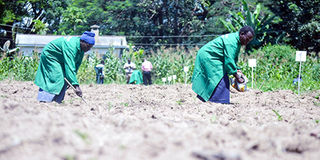Start of Bt cotton growing heralds better times, but State must go whole hog

Workers at Kalro's Kisumu Station prepare fields for planting Bt cotton during the National Performance Trials in 2018. Bt cotton is genetically engineered for pest resistance, especially against the African bollworm, a caterpillar pest. PHOTO | FILE | NATION MEDIA GROUP
What you need to know:
- Under the technology, strains of the bacterium Bacillus thungiensis (hence Bt) produce toxins that kill the bollworm, the most devastating of the cotton pests, which long developed resistance against insecticides such as synthetic pyrethroids.
- In a past conversation with Dr Charles Waturu, the director of the Kenya Agricultural Livestock and Research Organisation (Kalro), Thika, and a veteran of biotechnology trials, the three sprays will be for the control cotton strainers and aphids — the other important cotton pests that are not killed by Bt.
- Cotton is seen as a low-hanging fruit for Kenya because it grows in semi-arid conditions, which are to be found in many regions of Kenya, from western to the Coast.
- Kenya punches below its weight because it treats the sector that feeds the country and makes its money casually. It is moves such as embracing a variety with great potential to generate thousands of jobs that remind one of this possibility.
An event that has the potential to change the fortunes of Kenya’s agriculture passed rather quietly this week.
At Alupe in the border county of Busia, the government started distributing seeds for the growing of the genetically modified Bt cotton, which was okayed after years of research and much debate.
The important milestone in the checkered history of Kenya’s agriculture follows the Cabinet approval last December of the variety and partial lifting of a ban on GMOs that has been in place since 2012.
Bt cotton is genetically engineered for pest resistance, especially against the African bollworm, a caterpillar pest.
Under the technology, strains of the bacterium Bacillus thungiensis (hence Bt) produce toxins that kill the bollworm, the most devastating of the cotton pests, which long developed resistance against insecticides such as synthetic pyrethroids.
The chemical also killed the natural enemies of the African bollworms and red spider mites, another highly destructive pest.
Now, by enabling the plant to protect itself, the technology reduces the number of sprays from the present 12 to three, a development that is also good for human health and the environment. Besides, it has the added benefit of sparing the natural enemies, which will help in killing the red spider mite.
In a past conversation with Dr Charles Waturu, the director of the Kenya Agricultural Livestock and Research Organisation (Kalro), Thika, and a veteran of biotechnology trials, the three sprays will be for the control cotton strainers and aphids — the other important cotton pests that are not killed by Bt.
Dr Waturu estimates that Bt will reduce the cost of production by between 30 and 60 per cent.
GO THE WHOLE HOG
Bt cotton is grown in the US, Australia, China, South Africa, Burkina Faso and Sudan. India, a major textile hub, has 12 million hectares under the variety.
Cotton is seen as a low-hanging fruit for Kenya because it grows in semi-arid conditions, which are to be found in many regions of Kenya, from western to the Coast.
It is heartening that Agriculture Cabinet Secretary Peter Munya has assured that each demonstration farm will train 100 farmers in readiness for full commercial roll-out.
Currently, garments form one of the largest export items to the United States, accounting for close to $400 million sales a year, but the bulk of the fabric used in the Export Processing Zones are imported, with those employed there mainly cutting and stitching the garments.
The news of the beginning of the growing of Bt cotton is, therefore, to oil the wheels of factories that used to power local economies. It is to be hoped that the government will go the whole hog and revive other crops such as pyrethrum and cashew nuts, which were once cash cows but are now all but dead.
Launching a crop is just the beginning. Farmers need close attention from extension officers to nurture the crop to fruition.
Kenya punches below its weight because it treats the sector that feeds the country and makes its money casually. It is moves such as embracing a variety with great potential to generate thousands of jobs that remind one of this possibility.
Mr Sigei is Nation’s agriculture editor. Email: [email protected]



